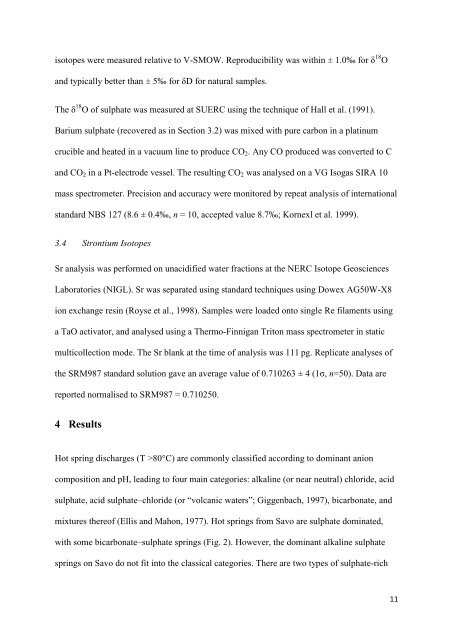Alkaline sulphate fluids produced in a magmatic hydrothermal system
Alkaline sulphate fluids produced in a magmatic hydrothermal system
Alkaline sulphate fluids produced in a magmatic hydrothermal system
Create successful ePaper yourself
Turn your PDF publications into a flip-book with our unique Google optimized e-Paper software.
isotopes were measured relative to V-SMOW. Reproducibility was with<strong>in</strong> ± 1.0‰ for δ 18 O<br />
and typically better than ± 5‰ for δD for natural samples.<br />
The δ 18 O of <strong>sulphate</strong> was measured at SUERC us<strong>in</strong>g the technique of Hall et al. (1991).<br />
Barium <strong>sulphate</strong> (recovered as <strong>in</strong> Section 3.2) was mixed with pure carbon <strong>in</strong> a plat<strong>in</strong>um<br />
crucible and heated <strong>in</strong> a vacuum l<strong>in</strong>e to produce CO 2 . Any CO <strong>produced</strong> was converted to C<br />
and CO 2 <strong>in</strong> a Pt-electrode vessel. The result<strong>in</strong>g CO 2 was analysed on a VG Isogas SIRA 10<br />
mass spectrometer. Precision and accuracy were monitored by repeat analysis of <strong>in</strong>ternational<br />
standard NBS 127 (8.6 ± 0.4‰, n = 10, accepted value 8.7‰; Kornexl et al. 1999).<br />
3.4 Strontium Isotopes<br />
Sr analysis was performed on unacidified water fractions at the NERC Isotope Geosciences<br />
Laboratories (NIGL). Sr was separated us<strong>in</strong>g standard techniques us<strong>in</strong>g Dowex AG50W-X8<br />
ion exchange res<strong>in</strong> (Royse et al., 1998). Samples were loaded onto s<strong>in</strong>gle Re filaments us<strong>in</strong>g<br />
a TaO activator, and analysed us<strong>in</strong>g a Thermo-F<strong>in</strong>nigan Triton mass spectrometer <strong>in</strong> static<br />
multicollection mode. The Sr blank at the time of analysis was 111 pg. Replicate analyses of<br />
the SRM987 standard solution gave an average value of 0.710263 ± 4 (1σ, n=50). Data are<br />
reported normalised to SRM987 = 0.710250.<br />
4 Results<br />
Hot spr<strong>in</strong>g discharges (T >80°C) are commonly classified accord<strong>in</strong>g to dom<strong>in</strong>ant anion<br />
composition and pH, lead<strong>in</strong>g to four ma<strong>in</strong> categories: alkal<strong>in</strong>e (or near neutral) chloride, acid<br />
<strong>sulphate</strong>, acid <strong>sulphate</strong>–chloride (or “volcanic waters”; Giggenbach, 1997), bicarbonate, and<br />
mixtures thereof (Ellis and Mahon, 1977). Hot spr<strong>in</strong>gs from Savo are <strong>sulphate</strong> dom<strong>in</strong>ated,<br />
with some bicarbonate–<strong>sulphate</strong> spr<strong>in</strong>gs (Fig. 2). However, the dom<strong>in</strong>ant alkal<strong>in</strong>e <strong>sulphate</strong><br />
spr<strong>in</strong>gs on Savo do not fit <strong>in</strong>to the classical categories. There are two types of <strong>sulphate</strong>-rich<br />
11
















